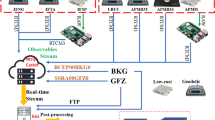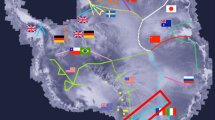Abstract
Galileo navigation system has significantly expanded satellite constellation over the last few years and now serves with 22 satellites in three orbital planes. The development of the Galileo is not only limited to the number of satellites in the space segment, but also the quality of the IGS MGEX products produced by different Analysis Centers has increased gradually and brought up the topic of investigation of the accuracy and precision of the Galileo-only positioning. However, almost all of the studies on Galileo-only positioning in the literature have been performed with Precise Point Positioning method and comprehensive studies with the relative positioning technique are quite a few. In this study, the development of the accuracy and precision of the Galileo from 2016 to the end of 2019 (4 years) has been investigated for the first time by means of relative positioning technique. For this purpose, data of eight GNSS stations selected from the IGS MGEX network were obtained and analyzed with GAMIT/GLOBK software as GPS-only and Galileo-only, separately. Using the daily solutions obtained from both navigation systems, time series were produced and the differences between them were compared in order to reveal the Galileo accuracy. According to the results, the accuracy of the Galileo was variable during the experiment and it could be examined in three periods. The averages of 3D positioning error in the first period (2016-2017) is 14.92 mm and improved by 56%, and decreased to 6.55 mm in the second period (2017-2018), and then improvement at 23% in the third period (2018 to the end of 2019) and decrescent to level of 5.13 mm on average for all stations. Similarly, standard deviations obtained from Galileo increased during the experiment and during the 3rd period it was closed to a few mm with GPS. It was concluded that the accuracy and precision of the Galileo showed parallel development and the development was directly related to the number of satellites in the Galileo constellation, and as a result, nowadays, Galileo-derived coordinates are close to the coordinates obtained from the GPS by a few mm.





Similar content being viewed by others
References
(2019) Galileo constellation information. https://www.gsc-europa.eu/system-service-status/constellation-information, accessed: 18.09.2019
(2019) GPS global positioning system official web site. https://www.gps.gov/systems/gps/space, accessed: 18.09.2019
(2019) MGEX the multi-gnss experiment and pilot project. http://mgex.igs.org/, accessed: 18.09.2019
(2019) Wikipedia galileo satellite navigation. https://en.wikipedia.org/wiki/Galileo_satellite_navigation, accessed: 18.09.2019
Bahadur B, Nohutcu M (2018) Ppph: a matlab-based software for multi-gnss precise point positioning analysis. GPS Solutions 22(4):113
Bahadur B, Nohutcu M (2019) Comparative analysis of mgex products for post-processing multi-gnss ppp. Measurement
Estey LH, Meertens CM (1999) Teqc: the multi-purpose toolkit for gps/glonass data. GPS solutions 3(1):42–49
Guo F, Li X, Zhang X, Wang J (2017) The contribution of multi-gnss experiment (mgex) to precise point positioning. Adv Space Res 59(11):2714–2725
Hadas T, Kazmierski K, Sośnica K (2019) Performance of galileo-only dual-frequency absolute positioning using the fully serviceable galileo constellation. GPS Solutions 23(4):108
Herring T, King R, McClusky S (2010) Introduction to gamit/globk. Massachusetts Institute of Technology, Cambridge
Mansur G, Sakic P, Männel B, Schuh H (2020) Multi-constellation gnss orbit combination based on mgex products. Adv Geosci 50:57–64
Pan L, Zhang X, Li X, Li X, Lu C, Liu J, Wang Q (2017) Satellite availability and point positioning accuracy evaluation on a global scale for integration of gps, glonass, beidou and galileo. Advances in Space Research
Paziewski J, Sieradzki R, Wielgosz P (2018) On the applicability of galileo foc satellites with incorrect highly eccentric orbits: an evaluation of instantaneous medium-range positioning. Remote Sens 10(2):208
Píriz R, Martín-Peiró B, Romay-Merino M (2005) The galileo constellation design: a systematic approach. In: Proceedings of the 18th international technical meeting of the satellite division of the institute of navigation (ION GNSS 2005), pp 1296–1306
Xia F, Ye S, Xia P, Zhao L, Jiang N, Chen D, Hu G (2019) Assessing the latest performance of galileo-only ppp and the contribution of galileo to multi-gnss ppp. Adv Space Res 63(9):2784– 2795
Yalvac S, Berber M (2018) Galileo satellite data contribution to gnss solutions for short and long baselines. Measurement 124:173– 178
Zaminpardaz S, Teunissen PJ (2017) Analysis of galileo iov+ foc signals and e5 rtk performance. GPS Solutions 21(4):1855–1870
Author information
Authors and Affiliations
Corresponding author
Additional information
Communicated by: H. Babaie
Publisher’s note
Springer Nature remains neutral with regard to jurisdictional claims in published maps and institutional affiliations.
Rights and permissions
About this article
Cite this article
Yalvac, S. Investigating the historical development of accuracy and precision of Galileo by means of relative GNSS analysis technique. Earth Sci Inform 14, 193–200 (2021). https://doi.org/10.1007/s12145-020-00560-8
Received:
Accepted:
Published:
Issue Date:
DOI: https://doi.org/10.1007/s12145-020-00560-8




